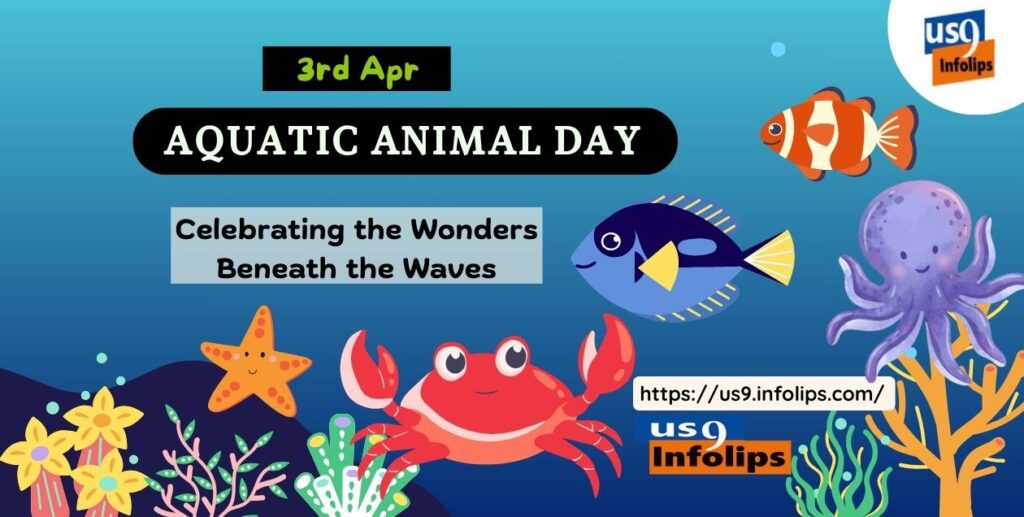Aquatic Animal Day: Celebrating the Wonders Beneath the Waves
Aquatic Animal Day: Celebrating the Wonders Beneath the Waves
Every year, Aquatic Animal Day reminds us of the incredible creatures living in our oceans, rivers, and lakes. But why do we celebrate it? Who started it? And what makes this day so special? Let’s dive deep into the world of aquatic animals and explore everything about this meaningful day.
Table of Contents
1. Why Was Aquatic Animal Day Started?
Aquatic Animal Day was created to raise awareness about marine and freshwater species, many of which are endangered due to pollution, overfishing, and climate change. It’s a day to appreciate their role in our ecosystem and take action to protect them.
2. Who Took the Initiative?
The day was first proposed by marine biologists and conservationists who saw the urgent need to highlight the threats faced by aquatic life. Organizations like the World Aquatic Animal Welfare Association (WAAWA) and Ocean Conservancy played a key role in promoting it.
3. The History Behind the Day
While the exact origin is debated, the concept gained momentum in the early 2000s as ocean conservation became a global concern. Events like World Oceans Day (June 8) inspired similar observances, leading to a dedicated day for aquatic animals.
4. How Is It Celebrated?
People celebrate by:
- Participating in beach cleanups
- Donating to marine conservation groups
- Educating others about endangered aquatic species
- Reducing plastic use to prevent ocean pollution
5. The Importance of Aquatic Animals
From tiny plankton to giant whales, aquatic animals:
- Maintain ocean balance
- Support fishing industries
- Produce oxygen (phytoplankton contribute to 50% of Earth’s oxygen!)
6. Threats They Face
- Overfishing – Many species are disappearing due to excessive fishing.
- Plastic Pollution – Millions of marine animals die from plastic waste yearly.
- Climate Change – Rising temperatures bleach coral reefs and disrupt habitats.
7. How Can We Help?
- Use eco-friendly products
- Support sustainable fishing
- Avoid single-use plastics
- Spread awareness on social media
8. Famous Aquatic Animals That Need Protection
- Vaquita Porpoise (the world’s most endangered marine mammal)
- Sea Turtles (threatened by plastic and fishing nets)
- Coral Reefs (dying due to ocean acidification)
9. Global Events on Aquatic Animal Day
Many aquariums, NGOs, and schools organize:
- Documentary screenings
- Underwater clean-up drives
- Fundraisers for marine conservation
The Future of Aquatic Animals
With growing awareness, more people are advocating for stronger laws against ocean pollution and overfishing. The hope is that future generations will still witness the beauty of thriving aquatic life.
9 Objectives of Aquatic Animal Day
- Raise awareness about endangered aquatic species.
- Promote sustainable fishing practices.
- Reduce plastic pollution in oceans.
- Advocate for stronger marine protection laws.
- Educate people about the ecological role of aquatic animals.
- Encourage beach and river clean-up initiatives.
- Support marine conservation organizations.
- Highlight the impact of climate change on aquatic life.
- Inspire individuals to adopt eco-friendly habits.
9 Facts About Aquatic Animal Day
- It is celebrated on different dates worldwide, but many observe it on April 3.
- Over 100 million marine animals die each year due to plastic waste.
- Whales help fight climate change by storing carbon in their bodies.
- Coral reefs support 25% of marine life but are dying rapidly.
- Octopuses have three hearts and blue blood.
- The ocean produces more oxygen than all rainforests combined.
- Sharks have existed for over 400 million years but are now endangered.
- Dolphins call each other by names (unique whistles).
- Seahorses are the only animals where males give birth.
9 Unknown Interesting Facts
- Some fish can recognize human faces.
- Jellyfish are biologically immortal (they don’t age).
- Electric eels can produce shocks up to 600 volts.
- Mantis shrimp have the most complex eyes in the animal kingdom.
- Pistol shrimp can create bubbles hotter than the sun’s surface.
- Sea sponges have no brain, heart, or organs but can live for centuries.
- Blue whales’ hearts are as big as a small car.
- Some deep-sea fish produce their own light (bioluminescence).
- Starfish can regenerate lost arms—some even grow a whole new body from one arm!
9 Controversies About Aquatic Animal Day
- Some argue it’s just symbolic without real policy changes.
- Commercial fishing industries oppose strict regulations.
- Artificial fish farms are criticized for poor animal welfare.
- Zoos and aquariums face backlash for keeping marine animals captive.
- Governments delay action on ocean protection laws.
- Climate change debates overshadow marine conservation.
- Plastic companies resist bans on single-use plastics.
- Overfishing continues illegally despite regulations.
- Some believe only “cute” marine animals (like dolphins) get attention, while others are ignored.
Conclusion
Aquatic Animal Day is more than just a celebration—it’s a call to action. These incredible creatures keep our oceans alive, and their survival depends on our choices. Whether it’s reducing plastic, supporting conservation, or simply learning more, every small effort counts. Let’s pledge to protect the wonders beneath the waves before it’s too late.
9 FAQs About Aquatic Animal Day
Q1. When is Aquatic Animal Day celebrated?
A: It varies, but many observe it on April 3.
Q2. Who started Aquatic Animal Day?
A: Marine conservationists and organizations like WAAWA promoted it.
Q3. Why are aquatic animals important?
A: They maintain ocean health, provide food, and produce oxygen.
Q4. How can I help protect aquatic animals?
A: Reduce plastic, support sustainable seafood, and join clean-ups.
Q5. What is the biggest threat to marine life?
A: Plastic pollution, overfishing, and climate change.
Q6. Are sharks endangered?
A: Yes, many shark species are at risk due to overfishing.
Q7. How much oxygen do oceans produce?
A: Phytoplankton generate 50% of Earth’s oxygen.
Q8. What is the most endangered marine animal?
A: The Vaquita porpoise, with fewer than 10 left.
Q9. Can fish feel pain?
A: Studies suggest yes, they have nervous systems that detect pain
Follow us for more captivating articles and stay connected to explore the world. Let’s embrace the power of communication and understanding.

Related topics:
1. Perfect World Travel Guide
2. 9 Most Popular EV Cars in the USA
3. 9 Best Things About Apple TV 4K – Third Generation
4. Think before You Renew Amazon Prime
5. Jimmy Carter: A Great Legacy
6. Memorial Day: Honoring the Sacrifice, Celebrating Freedom
School Site :
For English grammar and lot more : Smart School Infolips
Marathi Poems: Marathi Rang












